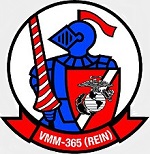Air Force 1 AF10012C USMC Bell-Boeing MV-22 Osprey Tiltrotor Aircraft - Marine Medium Tiltrotor Squadron 365 "Blue Knights", Marine Corps Air Station New River, North Carolina [Low-Vis Scheme] (1:72 Scale)
"Its [The V-22's] production costs are considerably greater than for helicopters with equivalent capability -- specifically, about twice as great as for the CH-53E, which has a greater payload and an ability to carry heavy equipment the V-22 cannot... an Osprey unit would cost around $60 million to produce, and $35 million for the helicopter equivalent."
- Michael E. O'Hanlon, senior fellow at The Brookings Institution, 2002
 The Bell Boeing V-22 Osprey is an American multi-mission, military, tiltrotor aircraft with both a vertical takeoff and landing (VTOL), and short takeoff and landing (STOL) capability. It is designed to combine the functionality of a conventional helicopter with the long-range, high-speed cruise performance of a turboprop aircraft.
The Bell Boeing V-22 Osprey is an American multi-mission, military, tiltrotor aircraft with both a vertical takeoff and landing (VTOL), and short takeoff and landing (STOL) capability. It is designed to combine the functionality of a conventional helicopter with the long-range, high-speed cruise performance of a turboprop aircraft.
The V-22 originated from the United States Department of Defense Joint-service Vertical take-off/landing Experimental (JVX) aircraft program started in 1981. The team of Bell Helicopter and Boeing Helicopters was awarded a development contract in 1983 for the tiltrotor aircraft. The Bell Boeing team jointly produce the aircraft. The V-22 first flew in 1989, and began flight testing and design alterations; the complexity and difficulties of being the first tiltrotor intended for military service in the world led to many years of development.
The United States Marine Corps began crew training for the Osprey in 2000, and fielded it in 2007; it is supplementing and will eventually replace their CH-46 Sea Knights. The Osprey's other operator, the U.S. Air Force, fielded their version of the tiltrotor in 2009. Since entering service with the U.S. Marine Corps and Air Force, the Osprey has been deployed in both combat and rescue operations over Iraq, Afghanistan and Libya.
Pictured here is a gorgeous 1:72 scale diecast replica of a USMC Bell-Boeing MV-22 Osprey tiltrotor aircraft that was attached to Marine Medium Tiltrotor Squadron 365 "Blue Knights".
Sold Out!
Dimensions:
Wingspan: 7-inches
Length: 8-inches
Release Date: March 2021
 Historical Account: "Blue Knights" - Marine Medium Tiltrotor Squadron 365 (VMM-365) is a United States Marine Corps tiltrotor squadron consisting of MV-22B Osprey transport aircraft. The squadron, known as the "Blue Knights", is based at Marine Corps Air Station New River, North Carolina and falls under the command of Marine Aircraft Group 26 (MAG-26) and the 2nd Marine Aircraft Wing (2nd MAW).
Historical Account: "Blue Knights" - Marine Medium Tiltrotor Squadron 365 (VMM-365) is a United States Marine Corps tiltrotor squadron consisting of MV-22B Osprey transport aircraft. The squadron, known as the "Blue Knights", is based at Marine Corps Air Station New River, North Carolina and falls under the command of Marine Aircraft Group 26 (MAG-26) and the 2nd Marine Aircraft Wing (2nd MAW).
The squadron was redesignated as Marine Medium Tiltrotor Squadron 365 on January 15th, 2009, after completing their conversion to the MV-22 Osprey. VMM-365 is the fifth squadron aboard MCAS New River to transition to the Osprey.
In January 2012, only eleven months after returning from a successful deployment to Afghanistan, VMM-365 returned to Camp Bastion to conduct combat operations in support of Operation Enduring Freedom. During the month of April, the squadron conducted 35 Named Operations and increased that number to 39 in May and 42 in June. VMM-365 flew in support of 193 Named Operations over the course of the seven-month deployment. By comparison, the squadron conducted just 10 Named Operations during OEF 10.2. In addition to successfully supporting an average of one Named Operation per day, the squadron moved 36,047 passengers and 769,102 pounds of cargo across the battle space while conducting General Support missions.
The squadron expanded the accepted capabilities of the MV-22 by operating across the spectrum of Assault Support and displaying wide-ranging and flexible skill sets. Centering on the primary mission of a VMM, the Blue Knights conducted conventional insertion/extraction operations, narcotic raids, Aerial Reaction Forces, and Aerial Interdiction. On March 25th, 2012, a flight of six Blue Knight Ospreys conducted the largest tiltrotor-borne insert in history by inserting 594 coalition personnel in support of Operation JAWS. VMM-365 also launched flights of three or more aircraft on 48 different occasions, to include 17 flights of five or more aircraft. Conducting long-range Casualty Evacuation missions within the critical "Golden Hour," leaflet drops in support of psychological operations, battlefield illumination missions for other MV-22s, and developing & operating as a Command and Control platform during three battalion-level operations are examples of some of the wide-ranging and innovative operations the Blue Knights successfully executed.


